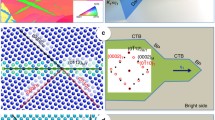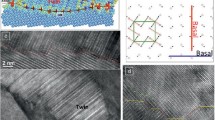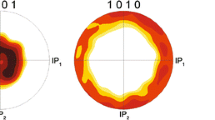Abstract
The topological model is applied to analyze defects associated with albite and pericline twins in plagioclase. Twin growth occurs by the motion of twinning disconnections. The same twinning disconnections are shown to produce both twins. The topological model is used to predict the atomic details of the disconnections. High-resolution transmission electron microscopy results verify the model predictions. Early work on the possibility of pseudo-twinning is also discussed.


(Hardouin Duparc 2017)












(Hirth et al. 2019)





Similar content being viewed by others
References
Anderson PM, Hirth JP, Lothe J (2017) Theory of dislocations, 3rd edn. Cambridge University Press, Cambridge
At Santoro, Mighell A (1970) Determination of reduced cells. Acta Crystallogr Sect A Cryst Phys Diffract Theor General Crystallogr 26:124–127
Bevis M, Crocker A (1969) Twinning modes in lattices. Proc R Soc Lond A 313:509–529
Bilby BA, Crocker A (1965) The theory of the crystallography of deformation twinning. Proc R Soc Lond A 288:240–255
Christian JW, Mahajan S (1995) Deformation twinning. Prog Mater Sci 39:1–157
Frank F (1951) Crystal dislocations-elementary concepts and definitions. Phil Mag 42:809–819
Frank F (1953) A note on twinning in alpha-uranium. Acta Metall 1:71–74
Fullman R, Fisher J (1951) Formation of annealing twins during grain growth. J Appl Phys 22:1350–1355
Gong M, Hirth JP, Liu Y, Shen Y, Wang J (2017) Interface structures and twinning mechanisms of twins in hexagonal metals. Mater Res Lett 5:449–464
Gong M, Xu S, Xie D, Wang S, Wang J, Schuman C, Lecomte J-S (2019) Steps and \(\left\{{\text{11}}\overline{{\text{2}}} {\text{1}}\right\}\) secondary twinning associated with \(\left\{{\text{112}}\overline{{\text{2}}}\right\}\) twin in titanium. Acta Mater 164:776–787
Hahn T, Klapper H (2006) 3.3 Twinning of crystals. International tables for crystallography D. Springer, Netherlands, pp 393–448
Han J, Thomas SL, Srolovitz DJ (2018) Grain-boundary kinetics: a unified approach. Prog Mater Sci 98:386–476
Hansen LN, Warren JM (2016) Quantifying the effect of pyroxene on deformation of peridotite in a natural shear zone. J Geophys Res Solid Earth 120:2717–2738
Hardouin Duparc O (2017) A review of some elements for the history of mechanical twinning centred on its German origins until Otto Mügge’s K 1 and K 2 invariant plane notation. J Mater Sci 52:4182–4196
Harlow GE, Brown GE (1980) Low albite- an X-ray and neutron diffraction study. Am Miner 65:986
Hartman NW, Bertoline GR, Wiebe EN, Ross WA (2008) Technical graphics communication. McGraw-Hill Education, New York, pp 577–578
Hazzledine P, Pirouz P (1993) Synchroshear transformations in Laves phases. Scr Metall Mater 28:1277–1282
Hirth J, Pond R, Hoagland R, Liu X-Y, Wang J (2013) Interface defects, reference spaces and the Frank–Bilby equation. Prog Mater Sci 58:749–823
Hirth J, Wang J, Tomé C (2016) Disconnections and other defects associated with twin interfaces. Prog Mater Sci 83:417–471
Hirth JP, Wang J, Hirth G (2019) A topological model for defects and interfaces in complex crystal structures. Am Mineral 104:966–972
Horst W, Tagai T, Korekawa M, Jagodzinski H (1981) Modulated structure of a plagiociase angz: theory and structure determination. Zeitschrift für Kristallographie Crystall Mater 157:233–250
Kelly A, Knowles KM (2012) Crystallography and crystal defects. Wiley, New York
Khater H, Serra A, Pond R (2013) Atomic shearing and shuffling accompanying the motion of twinning disconnections in zirconium. Phil Mag 93:1279–1298
Kronberg M (1957) Plastic deformation of single crystals of sapphire: basal slip and twinning. Acta Metall 5:507–524
Laves F (1952a) Phase relations of the alkali feldspars. II. The stable and pseudo-stable phase relations in the alkali feldspar system. J Geol 60:549–574
Laves F (1952b) Phase relations of the alkali feldspars: I. Introductory remarks. J Geol 60:436–450
Laves F, MacKenzie W, Zussman J (1974) Domain and deformation textures in plagioclase and their investigation by photo-emission-electron-microscopy (PEEM) and by transmission electron microscopy. Manchester University Press, Manchester, pp 536–550
Li B, Knowles KM (2013) Molecular dynamics simulation of albite twinning and pericline twinning in low albite. Modell Simul Mater Sci Eng 21:055012
McLaren A, Marshall D (1974) Transmission electron microscope study of the domain structures associated with the b-, c-, d-, e-and f-reflections in plagioclase feldspars. Contrib Miner Petrol 44:237–249
Mehl L, Hirth G (2008) Plagioclase preferred orientation in layered mylonites: evaluation of flow laws for the lower crust. J Geop Res 113:B05202
Miranda EA, Hirth G, John BE (2016) Microstructural evidence for the transition from dislocation creep to dislocation-accommodated grain boundary sliding in naturally deformed plagioclase. J Struct Geol 92:30–45
Mügge O (1889) Ueber homogene Deformationen (einfache Schiebungen) an den triklinen Doppelsalzen BaCdCl4. 4aq. Neues Jahrbuch für Mineral Geol Palaeontol Beilage 6:274–304
Nicolas A, Bouchez JL, Blaise J, Poirier JP (1977) Geological aspects of deformation in continental shear zones. Tectonophysics 42:55–73
Niggli P (1928) Krystallographische und strukturtheoretische Grundbegriffe. Akademische Verlagsgesellschaft MBH, Tübingen
Poirier J (1981) On the kinetics of olivine-spinel transition. Phys Earth Planet Inter 26:179–187
Pond R, Hirth J (2018) Topological model of type II deformation twinning. Acta Mater 151:229–242
Pond R, Serra A, Bacon D (1999) Dislocations in interfaces in the hcp metals—II. Mechanisms of defect mobility under stress. Acta Mater 47:1441–1453
Pond R, Ma X, Chai Y, Hirth J (2007) Topological modelling of martensitic transformations. Dislocations Solids 13:225–262
Pond RC, Hirth J, Serra A, Bacon D (2016) Atomic displacements accompanying deformation twinning: shears and shuffles. Mater Res Lett 4:185–190
Pond RC, Hirth JP, Knowles KM (2019) Topological model of type II deformation twinning in NiTi martensite. Phil Mag 99:1619–1634
Rowe KJ, Rutter EH (1990) Palaeostress estimation using calcite twinning: experimental calibration and application to nature. J Struct Geol 12(1):1–17
Smith JV (1974) Feldspar minerals: crystal structure and physical properties, vol 1. Springer, New York
Smith JV, Brown WL (2012) Feldspar minerals: crystal structures, physical, chemical, and microtextural properties, vol 1. Springer, Berlin
Stünitz H, Fitz Gerald J D, Tullis J (2003) Dislocation generation, slip systems, and dynamic recrystallization in experimentally deformed plagioclase single crystals. Tectonophysics 372 (3–4):215–233
Tullis J, Dell’Angelo LN, Yund RA (1998) Formation of ductile shear zones along former faults in feldspathic rocks. In: Snoke AW, Tullis J, Todd VR (eds) Fault-related rocks: a photographic atlas. Princeton Univ Press, Princeton, pp 252–253
Van Swygenhoven H, Derlet P (2008) Atomistic simulations of dislocations in FCC metallic nanocrystalline materials. Dislocations Solids Tribute FRN Nabarro 14:1
Wang J, Hirth JP, Tomé CN (2009) Twinning nucleation mechanisms in hexagonal close-packed crystals. Acta Mater 57:5521–5530
Wang J, Yu Q, Jiang Y, Beyerlein IJ (2014) Twinning-associated boundaries in hexagonal close-packed metals. JOM 66:95–101
Warren JM, Hirth JG (2006) Grain size sensitive deformation mechanisms in naturally deformed peridotites. Earth Planet Sci Lett 248:438–450
Wenk H-R, Bulakh A (2016) Minerals: their constitution and origin. Cambridge University Press, Cambridge
Xu S, Zhou P, Liu G, Xiao D, Gong M, Wang J (2019) Shock-induced two types of \(\left({\text{101}}\overline{{\text{2}}}\right)\) sequential twinning in titanium. Acta Mater 165:547–560
Yu Q, Wang J, Jiang Y, McCabe RJ, Li N, Tomé CN (2014a) Twin–twin interactions in magnesium. Acta Mater 77:28–42
Yu Q, Wang J, Jiang Y, McCabe RJ, Tomé CN (2014b) Co-zone \(\left({\text{1}}\overline{{\text{0}}} {\text{12}}\right)\) twin interaction in magnesium single crystal. Mater Res Lett 2:82–88
Zhu Y, Narayan J, Hirth J, Mahajan S, Wu X, Liao X (2009) Formation of single and multiple deformation twins in nanocrystalline FCC metals. Acta Mater 57:3763–3770
Acknowledgements
The authors are pleased to acknowledge helpful contributions by R.C. Pond. Xie and Wang acknowledge support from the US National Science Foundation (NSF) (CMMI-1661686). Greg Hirth acknowledges support from NSF: EAR-1624178.
Author information
Authors and Affiliations
Corresponding author
Additional information
Publisher's Note
Springer Nature remains neutral with regard to jurisdictional claims in published maps and institutional affiliations.
Appendix 1: Lattice site and atom exchanges
Appendix 1: Lattice site and atom exchanges
Almost all Burgers vectors in twins connect prefect lattice sites that are perfect translational t vectors in dichromatic spaces. However, there are a few cases where the vectors shear and shuffle to alternate sites in a process called synchroshear (Kronberg 1957). A better term is synchroshuffle, since the displacements are not the long-range ones defined by the Burgers vector. These are not perfect displacement vectors and create a special type of imperfect dislocation or disconnection. Examples of synchroshuffle include twinning, e.g., in alumina (Kronberg 1957), and phase transformations, e.g., in spinel (Poirier 1981) and Laves phases (Hazzledine and Pirouz 1993). The synchroshear displacements are of two kinds, knock-on and coupled pairs (Anderson et al. 2017). Synchroshear usually occurs in crystals with a basis, i.e., a structural group of atoms, or in simple structures a pair of atoms, at a lattice site that has point-group symmetry. For example, with a basis of 2, the dipole groups can be labeled as A and B. For more common cases, the shuffle or shear exchanges are A–A and B–B. For the synchronous cases the exchanges are A–B and B–A. To maintain stoichiometry there must be equal numbers of A–B and B–A exchanges. There are analogous displacements that we describe as anti-site exchanges. These arise during disconnection motion and entail atoms shuffling (or, less likely shearing) to the wrong site chemically. Again, there must be balanced A–B and B–A shifts.
Synchroshuffle was applied to twinning in alumina in the original work of Kronberg (1957). Often in twinning, the displacements are similar synchroshuffles. In twinning, the synchroshear/shuffle constraints often can be partly relaxed, as illustrated in the main text. For example, in a simulation of (\(10\overline{ 1} 2\)) twinning in Zr (Khater et al. 2013), knock-on, B–A and B–A exchanges (called swaps) occur. However, since the shuffle vectors simply complete perfect vector displacements from matrix to twin, no added fault is created. Thus, the distinction as an exchange is not as important. However, the exchange is of interest with regard to the atomic mechanism of motion. In contrast, the anti-site shuffles are important since they create local disorder, corresponding to a disorder fault in the wake of a moving disconnection. We describe the fault as a disorder fault since there is no incorrect layer stacking as in a stacking fault.
Rights and permissions
About this article
Cite this article
Xie, D., Hirth, G., Hirth, J.P. et al. Defects in deformation twins in plagioclase. Phys Chem Minerals 46, 959–975 (2019). https://doi.org/10.1007/s00269-019-01055-9
Received:
Accepted:
Published:
Issue Date:
DOI: https://doi.org/10.1007/s00269-019-01055-9




